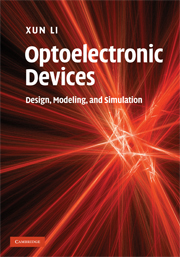Book contents
- Frontmatter
- Contents
- Preface
- 1 Introduction
- 2 Optical models
- 3 Material model I: Semiconductor band structures
- 4 Material model II: Optical gain
- 5 Carrier transport and thermal diffusion models
- 6 Solution techniques for optical equations
- 7 Solution techniques for material gain equations
- 8 Solution techniques for carrier transport and thermal diffusion equations
- 9 Numerical analysis of device performance
- 10 Design and modeling examples of semiconductor laser diodes
- 11 Design and modeling examples of other solitary optoelectronic devices
- 12 Design and modeling examples of integrated optoelectronic devices
- Appendices
- Index
4 - Material model II: Optical gain
Published online by Cambridge University Press: 09 October 2009
- Frontmatter
- Contents
- Preface
- 1 Introduction
- 2 Optical models
- 3 Material model I: Semiconductor band structures
- 4 Material model II: Optical gain
- 5 Carrier transport and thermal diffusion models
- 6 Solution techniques for optical equations
- 7 Solution techniques for material gain equations
- 8 Solution techniques for carrier transport and thermal diffusion equations
- 9 Numerical analysis of device performance
- 10 Design and modeling examples of semiconductor laser diodes
- 11 Design and modeling examples of other solitary optoelectronic devices
- 12 Design and modeling examples of integrated optoelectronic devices
- Appendices
- Index
Summary
Based on the single electron band structures that have been solved in Chapter 3, we are ready to derive models for calculation of material optical properties.
A comprehensive model with many-body effect
Introduction
As summarized in Table 4.1, a real world physics process is described in the time–space domain with time and space vectors as arguments. Through Fourier transform, we can also analyze this process in the frequency (energy) – wave vector (momentum) domain with the frequency and wave vector as arguments. The original arguments and their alternatives form conjugate pairs which satisfy Heisenberg's uncertainty relation.
Table 4.2 shows all possible combinations for describing a physics process in different domains.
Selecting a suitable domain to describe a physics process may bring the following advantages:
a derivative operation in the original domain (time or space) will become an algebraic operation in the alternative domain (frequency or momentum). Therefore, under an integration transform with the core function obtained from solving an eigenvalue problem, a linear differential equation can be converted to an algebraic equation. In particular, if the linear differential equation contains only invariant parameters, this integration transform is the Fourier transform where the plane wave function serves as the core function, as it is the eigenfunction of any linear and parameter invariant system.
any periodic function in one domain will be a discrete function after being transformed into its conjugate domain. For example, a periodic time domain function must have a discrete frequency or energy spectrum, a periodic space domain function must have a discrete wave vector or momentum dependence, and vice versa.
- Type
- Chapter
- Information
- Optoelectronic DevicesDesign, Modeling, and Simulation, pp. 102 - 150Publisher: Cambridge University PressPrint publication year: 2009



